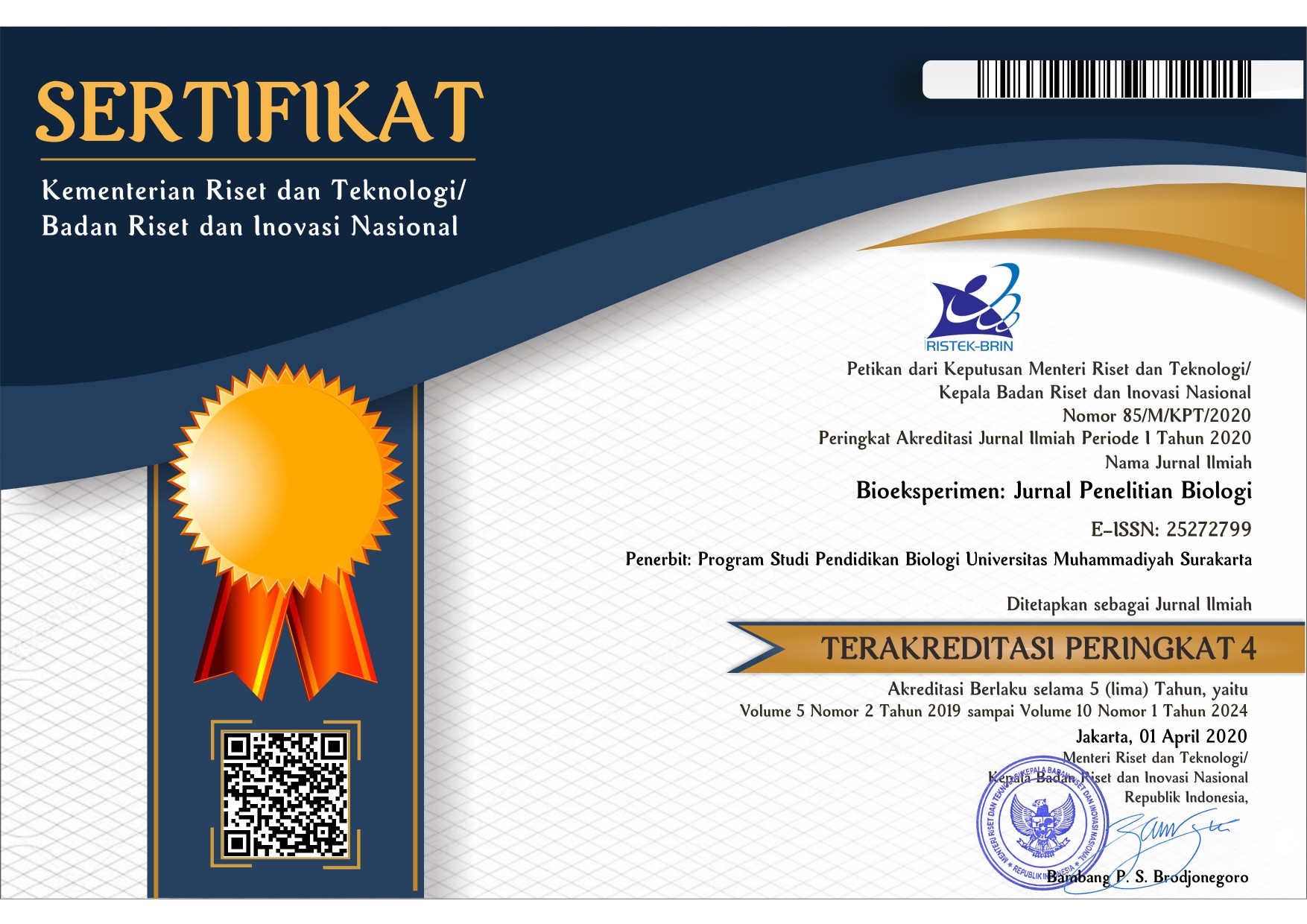Implementation of Bacteria Isolate as a Fertilizer and Bioinsecticide Agent for the Mealybug
Slamet Santosa(1*), Umi Fatmawati(2)(1) Biology Education Department, Sebelas Maret University, Kentingan, Jebres, Surakarta 57671
(2) Biology Education Department, Sebelas Maret University, Kentingan, Jebres, Surakarta 57671
(*) Corresponding Author
Abstract
Keywords
Full Text:
PDFReferences
Aarab, S., Ollero, F.J., Megías, M., Laglaoui, A., Bakkali, M. & Arakrak, A. (2015). Isolation and screening of bacteria from rhizospheric soils of rice fields in Northwestern Morocco for different plant growth promotion (PGP) activities: An in vitro study. Int. J. Curr. Microbiol. App. Sci. 4(1): 260-269.
Backer, R., Rokem, J. S., Ilangumaran, G., Lamont, J., Praslickova, D., Ricci, E., Subramanian, S., & Smith, D. L. (2018). Plant growth-promoting rhizobacteria: Context, mechanisms of action, and roadmap to commercialization of biostimulants for sustainable agriculture. Frontiers in Plant Science, 871(October), 1–17. https://doi.org/10.3389/fpls.2018.01473
Baihaqi, A. F., Yamika, W. S. D., & ... (2018). Pengaruh Lama Perendaman Benih dan Konsentrasi Penyiraman dengan PGPR Pada Pertumbuhan dan Hasil Tanaman Mentimun Produksi Tanaman, 6(5), 899–905. http://protan.studentjournal.ub.ac.id/index.php/protan/article/view/724.
Herlina, L., Kedati Pukan, K., & Mustikaningtyas, D. (2016). Kajian Bakteri Endofit Penghasil IAA (Indole Acetic Acid) Untuk Pertumbuhan Tanaman. Sainteknol: Jurnal Sains Dan Teknologi, 14(1), 51–58.
Kim, H. J., & Li, X. (2016). Effects of phosphorus on shoot and root growth, partitioning, and phosphorus utilization efficiency in Lantana. HortScience. 51(8): 1001–1009. https://doi.org/10.21273/hortsci.51.8.1001.
Krasilnikov, P., Taboada, M. A., & Amanullah. (2022). Fertilizer Use, Soil Health and Agricultural Sustainability. Agriculture (Switzerland), 12(4), 16–20. https://doi.org/10.3390/agriculture12040462.
Kumar, A., & Verma, J. P. (2019). The Role of Microbes to Improve Crop Productivity and Soil Health (Issue August). Springer Singapore. https://doi.org/10.1007/978-981-13-0149-0_14.
Manuhuttu, A. P., Rehatta, H., & Kailola, J. J. (2018). Pengaruh Konsentrasi Pupuk Hayati Bioboost Terhadap Peningkatan Produksi Tanaman Selada (Lactuca sativa. L). Agrologia, 3(1). https://doi.org/10.30598/a.v3i1.256.
Maron, P.-A., Sarr, A., Kaisermann, A., Leveque, J., Mathieu, O., Guigue, J., Karimi, B., Bernard, L., Dequidedt, S., Terrat, S., Chabbi, A., & Ranjard, L. (2018). High Microbial Diversity Promotes Soil Ecosystem Functioning. Apllied and Environmental Microbiology, 84(9), 1–13.
Mller, D., & Leyser, O. (2011). Auxin, cytokinin and the control of shoot branching. Ann. Bot. 107(7): 1203–1212. https://doi.org/10.1093/aob/mcr069.
Permatasari, A. D., & Nurhidayati, T. (2014). Pengaruh inokulan bakteri penambat nitrogen, bakteri pelarut fosfat dan mikoriza asal Desa Condro, Lumajang, Jawa Timur terhadap pertumbuhan tanaman cabai. Jurnal Sains dan Seni ITS, 3(2). http://ejurnal.its.ac.id/index.php/sains_seni/article/view/6868.
Sabarwal, A., Kumar, K., & Singh, R. P. (2018). Hazardous effects of chemical pesticides on human health–Cancer and other associated disorders. Environmental Toxicology and Pharmacology, 63(July), 103–114. https://doi.org/10.1016/j.etap.2018.08.018
Saida Aarab1, Francisco Javier Ollero3, Manuel Megías2, Amin Laglaoui1, M. B. and A. A. (2015). Isolation and screening of bacteria from rhizospheric soils of rice fields in Northwestern Morocco for different plant growth promotion (PGP) activities: An in vitro study. January.
Sharma, N., & Singhvi, R. (2017). Effects of Chemical Fertilizers and Pesticides on Human Health and Environment: A Review. International Journal of Agriculture, Environment and Biotechnology, 10(6), 675. https://doi.org/10.5958/2230-732x.2017.00083.3.
Suganthi, M., Abirami, G., Thenmozhi, M., Jayanthi, M., & Senthilkumar, P. (2021). Chitinase producing endophytic bacteria from calotropis gigantea: A promising perspective of biopesticide. Plant Cell Biotechnology and Molecular Biology, 22(1), 1–8.
Suherman, C., Soleh, M. A., Nuraini, A., & Fatimah, A. N. (2018). Pertumbuhan dan hasil tanaman cabai (Capsicum sp.) yang diberi pupuk hayati pada pertanaman kelapa sawit (Elaeis guineensis Jacq.) TBM I. Kultivasi, 17(2), 648–655. https://doi.org/10.24198/kultivasi.v17i2.18116.
Suryatmana, P., Kamaluddin, N. N., & Setiawati, M. R. (2022). Efektifitas Azotobacter sp. dan Pseudomonas sp. sebagai Plant Growth promoting Rhizobacteria (PGPR) terhadap tanaman Tomat (Lycopersicum esculentum Mill.) pada Andisol-Lembang. Soilrens, 20(1), 51. https://doi.org/10.24198/soilrens.v20i1.41364.
Walida, H., Harahap, F. S., Hasibuan, M., & Yanti, F. F. (2019). Isolasi Dan Identifikasi Bakteri Penghasil Iaa Dan Pelarut Fosfat Dari Rhizosfer Tanaman Kelapa Sawit. BIOLINK (Jurnal Biologi Lingkungan Industri Kesehatan), 6(1), 1–7. https://doi.org/10.31289/biolink.v6i1.2090.
Yahya, D. P. A., Hendarto, K., Yelli, F., & Widyastuti, R. A. D. (2022). Response of Biofertilizer Application and Alkali Supplement Fertilizer on the Growth and Yield of Curly Red Chili (Capsicum annuum L.). Jurnal Teknik Pertanian Lampung (Journal of Agricultural Engineering), 11(1), 15. https://doi.org/10.23960/jtep-l.v11i1.15-23.
Zhao, Y., Zhang, M., Yang, W., Di, H. J., Ma, L., Liu, W., & Li, B. (2019). Effects of microbial inoculants on phosphorus and potassium availability, bacterial community composition, and chili pepper growth in a calcareous soil: a greenhouse study. Journal of Soils and Sediments, 19(10), 3597–3607. https://doi.org/10.1007/s11368-019-02319-1.
Zhou, Z., Zhang, S., Jiang, N., Xiu, W., Zhao, J., & Yang, D. (2022). Effects of organic fertilizer incorporation practices on crops yield, soil quality, and soil fauna feeding activity in the wheat-maize rotation system. Frontiers in Environmental Science, 10(November), 1–13. https://doi.org/10.3389/fenvs.2022.1058071.
Article Metrics
Abstract view(s): 350 time(s)PDF: 249 time(s)
Refbacks
- There are currently no refbacks.








